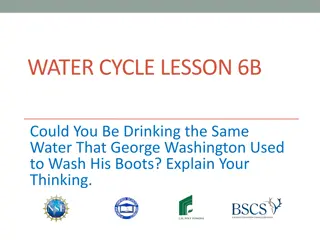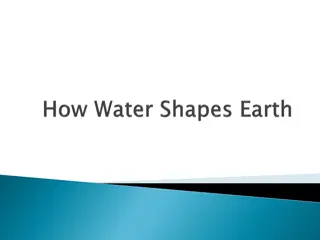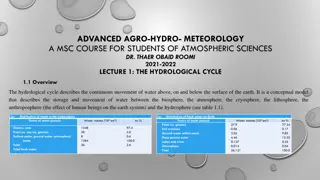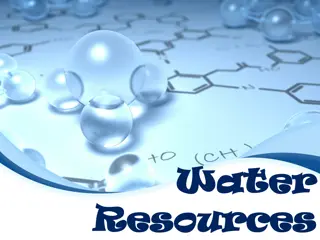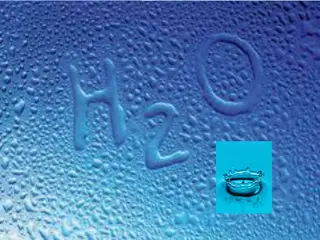Understanding Earth's Water Cycle and Atmospheric Processes
Explore the intricate workings of Earth's water cycle and atmospheric processes, including the distribution of water across various reservoirs, the significance of humidity in the atmosphere, and the influence of temperature on water vapor content. Gain insights into global wind patterns, pressure systems, and the vital role the atmosphere plays in water circulation. Delve into specific and relative humidity measurements, and discover how water is stored and moved throughout the Earth system.
Download Presentation

Please find below an Image/Link to download the presentation.
The content on the website is provided AS IS for your information and personal use only. It may not be sold, licensed, or shared on other websites without obtaining consent from the author. Download presentation by click this link. If you encounter any issues during the download, it is possible that the publisher has removed the file from their server.
E N D
Presentation Transcript
Atmospheric Circulation GEO101 Spring 2023
Contents The three states of water The global water balance Humidity Precipitation Atmospheric pressure Winds Global wind and pressure patterns
Majority of water occurs as ocean saltwater. Of the remaining water (only 2.8%), the majority is accounted for by glaciers and ice sheets, and groundwater. Only 0.001% occurs in the atmosphere.
The global water balance constantly cycles between these reservoirs. Note that even though the atmosphere contain relatively little water, it is responsible for the largest flow.
Humidity Humidity is the amount of water vapor in the atmosphere. Warm air can hold much more than cold air. Cold dry air can have close to 0% Warm tropical air may have 4-5% two ways to describe humidity (specific humidity and relative humidity).
Specific humidity is the actual quantity of water vapor in the air expressed as grams of water per kilogram of air (g/kg) Used to describe the water content of large air masses, and how it varies by latitude
Pole-to-pole specific humidity
Relative Humidity compares amount of water vapor present to the maximum amount that the air can hold at that temperature (%) E.g. if relative humidity is 50%, it contains half the amount it could have given the temperature. Relative humidity therefore changes as temperature changes.
Relative Humidity and temperature e.g. if temperature increases, if the amount of water vapor stays the same, then relative humidity decreases
Dew Point Temperature If air is cooled eventually it will be said to be saturated (100% relative humidity) = (dew point temperature) If cooling continues, condensation begins and dew forms
Clouds Made up of water droplets and/or ice particles Form when air is saturated and contains particles (condensation nuclei) e.g. dust, salts. Water can remain in liquid state below freezing (super cooled) to as low as -12 degrees.
Precipitation For precipitation to occur, it requires: growth of droplets in clouds ice - crystal process - ice particles act as freezing nuclei coalescence process - large droplets collide with smaller ones All precipitation begins as frozen water.
Types of Precipitation: freezing rain (ice crystals freeze onto a frozen surface) snow (ice crystals have not melted) sleet (ice crystals melt as they fall) hail (melting and refreezing crystals that form in thunder clouds)
Orographic precipitation Air rising over a mountain Intercepting slope = Windward slope (wetter) Leeward slope (drier) (rain shadow)
Convectional Precipitation Warm air rises and cools to dew point and clouds form. Latent heat release. adds energy and increases updraft produces thunderstorms
Frontal (cyclonic) precipitation where air masses with different temperatures come together warm air lifted by cold dense air along a weather front leads to frontal precipitation
Atmospheric Pressure As the atmosphere is held down by gravity, it exerts a force upon every surface (pressure = force per unit area). At sea level the force is the weight of 1 kg of air that lies above each square centimeter of the surface (around 15 lbs. per inch)
Atmospheric pressure decreases rapidly with altitude near the surface. Therefore, a small change in elevation will often produce a significant change in air pressure.
Differences in air pressure = a pressure gradient The pressure gradient forces act at right angles to the isobars (90 degrees). 820 820 830 830 840 850 840 860 870 850 880 890 860 strong pressure gradient weak pressure gradient
Land and Sea breezes During the day, air over land heats up and the sea is relatively cool (sea breeze). land = low pressure and sea = high pressure At night air over land cools and the sea is relatively warm (land breeze). land = high pressure and sea = low pressure
High pressure (anticyclone) Side View From above H H L L L Air descends. Surrounding air is relatively low.
Low pressure (depressions, cyclone) Side View From above L L H H H Air ascends. Surrounding air is relatively high.
low pressure pressure geostrophic gradient force winds 992 996 1000 1004 1008 1012 1016 1020 high pressure
The planet Earth rotates. In the northern hemisphere air appears to be deflected to the right. In the southern hemisphere, it deflected to the left. this deflective force = Coriolis force because the wind is deflected it now flows parallel to the isobars = geostrophic wind
Imagine a turntable When not turning, a ball traces straight line. When moving, ball traces a curved line. Friction forces As wind flows over the surface friction reduces the speed. Friction also changes the direction of the geostrophic wind. The pressure gradient force overpowers the Coriolis effect. As a result, wind flow across the isobars.
Upper atmosphere at 5-7 km above the surface influenced only by pressure gradient force and Coriolis force geostrophic winds that flow parallel to isobars
General Circulation of the Earths Atmosphere Deflection is least at the equator and greatest at the poles Deflection No Deflection Deflection
L H Northern Hemisphere L H Southern Hemisphere
General Circulation of the Earths Atmosphere Deflection is least at the equator and greatest at the poles.
l H h L l H SUN L H
Warm air rises and flows poleward. LOW PRESSURE L So, around the equator = ITCZ (Inter-Tropical Convergence) Zone Variable center is calm known as the Doldrums .
Warmer air rises Cold air sinks HIGH PRESSURE At around 30 degrees North and South is the Subtropical High because cool air sinks here. Subpolar low pressure because the warmer air of the mid-latitudes rises as it meets cold polar air
Trade winds are predictable. Northeast in Northern hemisphere Southeast in Southern hemisphere At subtropical high conditions are calm. known as the horse latitudes
From the subtropical high to the subpolar low = westerlies Includes variable low and high pressure systems At the Polar Front cold and warm air meet - storms form. From the Polar High to the subpolar low are the Polar easterlies - variable
Monsoons In January high pressure over the land produces dry winds. Air is flowing towards the ITCZ. In July the position of the ITCZ moves North. Low pressure over the land causes winds to flow off the ocean. This brings heavy rainfall.
Smooth westward flow of upper air westerlies Rossby Waves Develop at the polar front, and form convoluted waves eventually pinch off Primary mechanism for poleward heat transfer Pools of cool air create areas of low pressure
Jet Streams Narrow bands of high velocity Form along the polar front and above the Hadley cell in the subtropics












